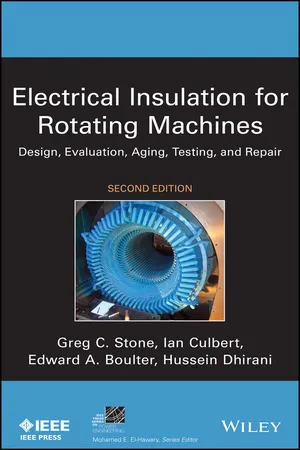
Electrical Insulation for Rotating Machines
Design, Evaluation, Aging, Testing, and Repair
- English
- ePUB (mobile friendly)
- Available on iOS & Android
Electrical Insulation for Rotating Machines
Design, Evaluation, Aging, Testing, and Repair
About this book
A fully expanded new edition documenting the significant improvements that have been made to the tests and monitors of electrical insulation systems
Electrical Insulation for Rotating Machines: Design, Evaluation, Aging, Testing, and Repair, Second Edition covers all aspects in the design, deterioration, testing, and repair of the electrical insulation used in motors and generators of all ratings greater than fractional horsepower size. It discusses both rotor and stator windings; gives a historical overview of machine insulation design; and describes the materials and manufacturing methods of the rotor and stator winding insulation systems in current use (while covering systems made over fifty years ago). It covers how to select the insulation systems for use in new machines, and explains over thirty different rotor and stator winding failure processes, including the methods to repair, or least slow down, each process. Finally, it reviews the theoretical basis, practical application, and interpretation of forty different tests and monitors that are used to assess winding insulation condition, thereby helping machine users avoid unnecessary machine failures and reduce maintenance costs.
Electrical Insulation for Rotating Machines:
- Documents the large array of machine electrical failure mechanisms, repair methods, and test techniques that are currently available
- Educates owners of machines as well as repair shops on the different failure processes and shows them how to fix or otherwise ameliorate them
- Offers chapters on testing, monitoring, and maintenance strategies that assist in educating machine users and repair shops on the tests needed for specific situations and how to minimize motor and generator maintenance costs
- Captures the state of both the present and past "art" in rotating machine insulation system design and manufacture, which helps designers learn from the knowledge acquired by previous generations
An ideal read for researchers, developers, and manufacturers of electrical insulating materials for machines, Electrical Insulation for Rotating Machines will also benefit designers of motors and generators who must select and apply electrical insulation in machines.
Frequently asked questions
- Essential is ideal for learners and professionals who enjoy exploring a wide range of subjects. Access the Essential Library with 800,000+ trusted titles and best-sellers across business, personal growth, and the humanities. Includes unlimited reading time and Standard Read Aloud voice.
- Complete: Perfect for advanced learners and researchers needing full, unrestricted access. Unlock 1.4M+ books across hundreds of subjects, including academic and specialized titles. The Complete Plan also includes advanced features like Premium Read Aloud and Research Assistant.
Please note we cannot support devices running on iOS 13 and Android 7 or earlier. Learn more about using the app.
Information
Chapter 1
Rotating Machine Insulation Systems
1.1 Types of Rotating Machines
1.1.1 AC Motors
Squirrel Cage Induction (SCI) Motor

Wound Rotor Induction Motor
Synchronous Motor
1.1.2 Synchronous Generators
Round Rotor Generators
Table of contents
- Cover
- Series
- Title Page
- Copyright
- Preface
- Chapter 1: Rotating Machine Insulation Systems
- Chapter 2: Evaluating Insulation Materials and Systems
- Chapter 3: Historical Development of Insulation Materials and Systems
- Chapter 4: Stator Winding Insulation Systems in Current Use
- Chapter 5: Rotor Winding Insulation Systems
- Chapter 6: Rotor and Stator Laminated Cores
- Chapter 7: General Principles of Winding Failure, Repair and Rewinding
- Chapter 8: Stator Failure Mechanisms and Repair
- Chapter 9: Round Rotor Winding Failure Mechanisms and Repair
- Chapter 10: Salient Pole Rotor Winding Failure Mechanisms and Repair
- Chapter 11: Wound Rotor Winding Failure Mechanisms and Repair
- Chapter 12: Squirrel Cage Induction Rotor Winding Failure Mechanisms and Repair
- Chapter 13: Core Lamination Insulation Failure and Repair
- Chapter 14: General Principles of Testing and Monitoring
- Chapter 15: Off-Line Rotor and Stator Winding Tests
- Chapter 16: In-Service Monitoring of Stator and Rotor Windings
- Chapter 17: Core Testing
- Chapter 18: New Machine Winding and Rewind Specifications
- Chapter 19: Acceptance and Site Testing of New Windings
- Chapter 20: Maintenance Strategies
- Appendix A
- Appendix B
- Index
- Series
- End User License Agreement